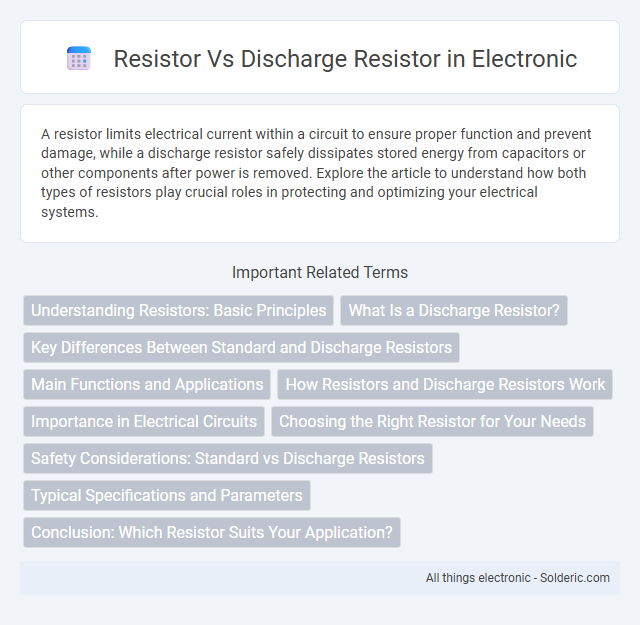A resistor limits electrical current within a circuit to ensure proper function and prevent damage, while a discharge resistor safely dissipates stored energy from capacitors or other components after power is removed. Explore the article to understand how both types of resistors play crucial roles in protecting and optimizing your electrical systems.
Comparison Table
| Feature | Resistor | Discharge Resistor |
|---|---|---|
| Primary Function | Limits electrical current in circuits | Safely discharges stored energy from capacitors or inductors |
| Application | General electronic circuits, voltage division, signal conditioning | Power supplies, capacitive circuits, high voltage equipment |
| Power Rating | Typically low to medium (0.125W to 5W) | High power rating (often 5W and above) to handle sudden discharge energy |
| Construction | Various forms: film, wire wound, carbon | Usually wire wound or metal oxide for high pulse and thermal endurance |
| Resistance Range | Ohms to megaohms, depending on use | Often low to medium resistance to allow quick energy dissipation |
| Thermal Handling | Moderate heat dissipation | Designed for rapid heat rise and cooldown during discharge |
| Typical Example | 10kO 0.25W resistor in a voltage divider | 100O 10W resistor used to discharge a high voltage capacitor bank |
Understanding Resistors: Basic Principles
A resistor limits electrical current flow by providing a precise resistance value measured in ohms, ensuring circuit stability and protecting components from damage. A discharge resistor specifically dissipates stored electrical energy from capacitors or inductors to safely reduce voltage after power-off, preventing hazards. Understanding these basic principles helps you design safer and more reliable electronic circuits by choosing the appropriate resistor type for each application.
What Is a Discharge Resistor?
A discharge resistor is a specialized resistor designed to safely dissipate stored electrical energy from capacitors or other components after power is turned off, preventing electric shock or equipment damage. Unlike standard resistors that primarily regulate current, discharge resistors quickly reduce residual voltage by providing a controlled path for energy release. Understanding the role of a discharge resistor ensures your electronic systems remain safe and reliable during power-down sequences.
Key Differences Between Standard and Discharge Resistors
Standard resistors primarily regulate current flow and voltage in electronic circuits by providing consistent resistance, while discharge resistors are specifically designed to safely dissipate stored energy from capacitors or other components after power-off to prevent electrical hazards. Discharge resistors often feature higher power ratings and durability to handle rapid energy release, unlike standard resistors which deal with steady-state conditions. Understanding your circuit's requirements ensures the correct resistor type is chosen to maintain safety and performance.
Main Functions and Applications
Resistors primarily regulate current flow and divide voltage in electronic circuits, ensuring stable operation of components and protecting devices from damage. Discharge resistors specifically provide a safe path to dissipate stored electrical energy from capacitors or other energy storage devices after power is switched off, preventing hazardous voltage buildup. Applications of resistors include voltage regulation and signal conditioning, while discharge resistors are critical in power supplies, capacitor banks, and renewable energy systems to enhance safety during maintenance.
How Resistors and Discharge Resistors Work
Resistors regulate electrical current by providing a specific resistance value that limits the flow of electrons through a circuit, ensuring proper voltage and current levels. Discharge resistors specifically manage the safe dissipation of stored electrical energy from capacitors or other components by converting the remaining charge into heat, preventing potential damage or hazards. Your electrical systems rely on precise resistor functions to maintain stability and safety through controlled energy flow and discharge.
Importance in Electrical Circuits
Resistors play a crucial role in controlling current and voltage levels within electrical circuits, ensuring the protection of components from damage caused by excessive current. Discharge resistors are essential for safely dissipating stored energy in capacitors or other passive components after power is turned off, preventing electrical hazards and equipment damage. Your careful selection and use of these resistors improve circuit reliability and safety during both operation and shutdown phases.
Choosing the Right Resistor for Your Needs
When selecting between a standard resistor and a discharge resistor, consider the application's voltage rating, power dissipation, and safety requirements. Discharge resistors are specifically designed to safely dissipate stored energy in capacitive circuits, preventing dangerous voltage buildup after power-off. Choosing the right resistor ensures Your circuit operates efficiently while maintaining protection against electrical hazards.
Safety Considerations: Standard vs Discharge Resistors
Standard resistors primarily manage current flow and voltage levels but do not safely dissipate stored energy in capacitive circuits, posing potential shock hazards. Discharge resistors are specifically designed to safely discharge stored electrical energy, preventing accidental electric shocks and equipment damage. Your electrical system's safety significantly improves with discharge resistors, as they ensure voltage levels return to safe values after power is removed.
Typical Specifications and Parameters
A resistor typically has power ratings ranging from 0.1W to 10W, resistance values from a few ohms to several megaohms, and tolerance levels between +-1% to +-10%, designed primarily for current limiting or voltage division in circuits. A discharge resistor features higher power ratings, often above 5W, with resistance values optimized to safely discharge capacitors by dissipating stored energy quickly and reliably, also emphasizing safety and durability under transient loads. Your choice depends on whether you need precise resistance for circuit operation or a robust component capable of safely managing energy discharge.
Conclusion: Which Resistor Suits Your Application?
A standard resistor regulates current flow and dissipates energy in electronic circuits, while a discharge resistor safely releases stored energy from capacitors or high-voltage equipment to prevent shock hazards. When choosing the right resistor for your application, consider whether your primary need is current control or the safe discharge of residual charge. Your decision hinges on the specific function: select a discharge resistor for safety in high-voltage systems, and a regular resistor for general circuit operation.
resistor vs discharge resistor Infographic

 solderic.com
solderic.com